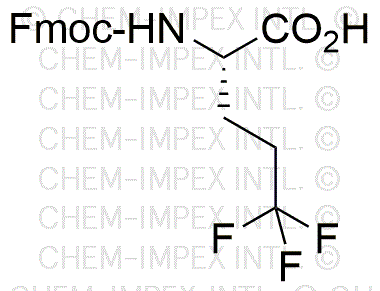(S)-Fmoc-2-amino-5,5,5-trifluoropentanoic acid is widely utilized in research focused on
- Peptide Synthesis: This compound serves as a key building block in the synthesis of peptides, particularly in solid-phase peptide synthesis (SPPS), allowing for the incorporation of fluorinated amino acids that can enhance the stability and bioactivity of the resulting peptides.
- Drug Development: Its unique trifluoromethyl group can improve the pharmacokinetic properties of drug candidates, making it valuable in pharmaceutical research for developing more effective therapeutics.
- Bioconjugation: The Fmoc protecting group allows for selective reactions in bioconjugation processes, facilitating the attachment of biomolecules to surfaces or other molecules, which is crucial in the development of targeted drug delivery systems.
- Material Science: This compound can be used in the creation of advanced materials, particularly in coatings or polymers that require enhanced chemical resistance and durability due to the presence of fluorine.
- Research in Fluorine Chemistry: It provides a platform for exploring the effects of fluorination in various chemical reactions, helping researchers understand the role of fluorine in modifying biological and chemical properties.
General Information
Properties
Safety and Regulations
Applications
(S)-Fmoc-2-amino-5,5,5-trifluoropentanoic acid is widely utilized in research focused on
- Peptide Synthesis: This compound serves as a key building block in the synthesis of peptides, particularly in solid-phase peptide synthesis (SPPS), allowing for the incorporation of fluorinated amino acids that can enhance the stability and bioactivity of the resulting peptides.
- Drug Development: Its unique trifluoromethyl group can improve the pharmacokinetic properties of drug candidates, making it valuable in pharmaceutical research for developing more effective therapeutics.
- Bioconjugation: The Fmoc protecting group allows for selective reactions in bioconjugation processes, facilitating the attachment of biomolecules to surfaces or other molecules, which is crucial in the development of targeted drug delivery systems.
- Material Science: This compound can be used in the creation of advanced materials, particularly in coatings or polymers that require enhanced chemical resistance and durability due to the presence of fluorine.
- Research in Fluorine Chemistry: It provides a platform for exploring the effects of fluorination in various chemical reactions, helping researchers understand the role of fluorine in modifying biological and chemical properties.
Documents
Safety Data Sheets (SDS)
The SDS provides comprehensive safety information on handling, storage, and disposal of the product.
Product Specification (PS)
The PS provides a comprehensive breakdown of the product’s properties, including chemical composition, physical state, purity, and storage requirements. It also details acceptable quality ranges and the product's intended applications.
Certificates of Analysis (COA)
Search for Certificates of Analysis (COA) by entering the products Lot Number. Lot and Batch Numbers can be found on a product’s label following the words ‘Lot’ or ‘Batch’.
Número de catálogo
Número de lote/lote
Certificates Of Origin (COO)
This COO confirms the country where the product was manufactured, and also details the materials and components used in it and whether it is derived from natural, synthetic, or other specific sources. This certificate may be required for customs, trade, and regulatory compliance.
Número de catálogo
Número de lote/lote
Safety Data Sheets (SDS)
The SDS provides comprehensive safety information on handling, storage, and disposal of the product.
DownloadProduct Specification (PS)
The PS provides a comprehensive breakdown of the product’s properties, including chemical composition, physical state, purity, and storage requirements. It also details acceptable quality ranges and the product's intended applications.
DownloadCertificates of Analysis (COA)
Search for Certificates of Analysis (COA) by entering the products Lot Number. Lot and Batch Numbers can be found on a product’s label following the words ‘Lot’ or ‘Batch’.
Número de catálogo
Número de lote/lote
Certificates Of Origin (COO)
This COO confirms the country where the product was manufactured, and also details the materials and components used in it and whether it is derived from natural, synthetic, or other specific sources. This certificate may be required for customs, trade, and regulatory compliance.


